Solar Powered Thermoelectric Air Conditioning for Temperature Control in Poultry Incubators
Abstract
1. Introduction
2. System Overview and Components
3. Mathematical Modelling and Design Calculations
3.1. Mathematical Modelling of Thermoelectric Module
- T—absolute temperature;
- —Seebeck constant;
- —electrical resistivity;
- k—thermal conductivity.
- —the length of the thermocouple on the p side;
- —the length of the thermowell at the n side;
- —the thermocouple area of the cross section on the p side;
- —the thermocouple area of the cross section on the n side;
- —the thermal conductivity at p side of the thermocouple;
- —the thermal conductivity at the n-sided thermocouple;
- —the temperature at the hot side of the thermocouple;
- —the number of thermocouples.
3.2. Mathematical Modelling of Solar Thermoelectric Module
- is the electrical power in kilowatt (kW).
- —solar panel cross-sectional area (square meter);
- —solar irradiation (kW/square meter).
3.3. Design Calculations
- (1)
- Monocrystalline solar panel;
- (2)
- MPPT solar charge controller;
- (3)
- Lead–acid tubular battery;
- (4)
- Two Peltier modules;
- (5)
- Two heat sinks;
- (6)
- Two temperature sensors;
- (7)
- Two temperature controllers;
- (8)
- Two exhaust and two cooling fans.
4. Hardware Results and Analysis
4.1. Block Diagram of the Proposed Hardware
4.2. Steps in Validating the Proposed Hardware Setup
4.2.1. Testing of Peltier Module 1 and 2
4.2.2. Testing of Temperature Controllers
4.2.3. Testing of the Whole Assembly with the SMPS
4.2.4. Testing of Whole Assembly with Solar Panel, Charge Controller, and Battery
5. Conclusions
Author Contributions
Funding
Institutional Review Board Statement
Informed Consent Statement
Data Availability Statement
Acknowledgments
Conflicts of Interest
References
- Kaiprath, J.; Kishor Kumar, V.V. A review on solar photovoltaic-powered thermoelectric coolers, performance enhancements, and recent advances. Int. J. Air-Cond. Refrig. 2023, 31, 6. [Google Scholar] [CrossRef]
- Soorej, T. Solar Thermo-Electric Cooler cum Warmer. 2016. Available online: https://www.researchgate.net/publication/355425044_Solar_Thermo-Electric_Cooler_cum_Warmer (accessed on 5 May 2024).
- Alam, N.; Ali, M.S.; Sajid, S.; Sharma, D.; Hasan, Z. Experimental investigation and analysis of cooling performance of solar thermoelectric refrigerator. Sol. Energy 2023, 263, 111892, ISSN 0038-092X. [Google Scholar] [CrossRef]
- Islam, N.; Islam, R.; Rana, J.; Zaman, H.U. A Novel Design of A Dual-Powered Automatic Peltier Effect Cooler. In Proceedings of the 2020 IEEE Region 10 Symposium (TENSYMP), Dhaka, Bangladesh, 5–7 June 2020; pp. 287–290. [Google Scholar] [CrossRef]
- Anarbaev, A.; Zakhidov, R.; Tursunov, O.; Kodirov, D.; Vakhidov, U.; Khaliknazarov, U.; Yusupov, Z.; Kushev, A. Using of evaporative cooling systems in poultry farms. IOP Conf. Ser. Earth Environ. Sci. 2020, 614, 012015. [Google Scholar] [CrossRef]
- Shahzad, K.; Sultan, M.; Bilal, M.; Ashraf, H.; Farooq, M.; Miyazaki, T.; Sajjad, U.; Ali, I.; Hussain, M.I. Experiments on Energy-Efficient Evaporative Cooling Systems for Poultry Farm Application in Multan (Pakistan). Sustainability 2021, 13, 2836. [Google Scholar] [CrossRef]
- Hoff, S.J. HVAC Techniques for Modern Livestock and Poultry Production Systems; HVAC System; InTech: London, UK, 2018. [Google Scholar] [CrossRef]
- Feng, Q.; Wang, B.; Zhang, W.; Li, X. Development and Test of Spraying Robot for Anti-epidemic and Disinfection in Animal Housing. In Proceedings of the 2021 WRC Symposium on Advanced Robotics and Automation (WRC SARA), Beijing, China, 11 September 2021; pp. 24–29. [Google Scholar] [CrossRef]
- Evstatiev, B.; Evstatieva, N. Conceptual Model of a System for Controlling the Process of Egg-Hatching in Incubators. In Proceedings of the 2022 IEEE 28th International Symposium for Design and Technology in Electronic Packaging (SIITME), Bucharest, Romania, 26–29 October 2022; pp. 17–22. [Google Scholar] [CrossRef]
- Bari, M.A.; Hossain, M.J.; Khan, M.M. Development of Smart Egg Incubator. In Proceedings of the 2021 IEEE 12th Annual Ubiquitous Computing, Electronics & Mobile Communication Conference (UEMCON), New York, NY, USA, 1–4 December 2021; pp. 0527–0533. [Google Scholar] [CrossRef]
- Jaichandran, R.; Shobana, R.; Tharick, K.M.; Raja, L.; Anandaram, H.; Vijaipriya, K. Automatic Hatching System by designing IoT-based Egg Incubator. In Proceedings of the 2022 3rd International Conference on Smart Electronics and Communication (ICOSEC), Trichy, India, 20–22 October 2022; pp. 501–506. [Google Scholar] [CrossRef]
- Wickramasinghe, S.; Jayasinghe, J.; Senadeera, M. Compact battery-free UHF RFID tag for temperature measurement in poultry egg incubators. In Proceedings of the 2023 IEEE 17th International Conference on Industrial and Information Systems (ICIIS), Peradeniya, Sri Lanka, 25–26 August 2023; pp. 1–6. [Google Scholar] [CrossRef]
- Herrera, S.; Lizano, D.; Díaz, N. Design approach of a trout egg sorting machine based on convolutional neural networks with water conditions monitoring. In Proceedings of the 2021 IEEE Sciences and Humanities International Research Conference (SHIRCON), Lima, Peru, 17–19 November 2021; pp. 1–4. [Google Scholar] [CrossRef]
- Duvanov, E.S.; Kudinov, Y.I.; Pashchenko, F.F.; Duvanova, V.S. Analysis of the Technological Process of Egg Incubation and Formulation of the Control Problem. In Proceedings of the 2021 3rd International Conference on Control Systems, Mathematical Modeling, Automation and Energy Efficiency (SUMMA), Lipetsk, Russia, 10–12 November 2021; pp. 769–773. [Google Scholar] [CrossRef]
- Siby, J.; Tomy, A.; Shaji, A.; Chacko, R.; Sankar, V. Self Regulated Solar Powered IoT Based Egg Incubator. In Proceedings of the 2022 IEEE 19th India Council International Conference (INDICON), Kochi, India, 24–26 November 2022; pp. 1–6. [Google Scholar] [CrossRef]
- Kumar, P.V.; Obulesu, Y.P. Solar Incubator for Hatching of Eggs using Different Controllers: A Critical Review. In Proceedings of the 2021 Innovations in Power and Advanced Computing Technologies (i-PACT), Kuala Lumpur, Malaysia, 27–29 November 2021; pp. 1–8. [Google Scholar] [CrossRef]
- Amornsawatwattana, I.; Son-In, S.; Phanak, W. Analysis of Temperature Distribution from The Comparison Egg Incubator Shape by 3-D Finite Element Method. In Proceedings of the 2022 International Electrical Engineering Congress (iEECON), Khon Kaen, Thailand, 9–11 March 2022; pp. 1–4. [Google Scholar] [CrossRef]
- Chitra, K.; Kalpana, T.; Hemalatha, M.; Vishnu, S.H.; Kishore, K.; Manoj, S. Automatic Egg Incubator Using IoT. In Proceedings of the 2023 International Conference on Computer Communication and Informatics (ICCCI), Coimbatore, India, 23–25 January 2023; pp. 1–5. [Google Scholar] [CrossRef]
- Liang, Y.; Tabler, G.T.; Dridi, S. Sprinkler Technology Improves Broiler Production Sustainability: From Stress Alleviation to Water Usage Conservation: A Mini Review. Front. Vet. Sci. 2020, 7, 544814. [Google Scholar] [CrossRef] [PubMed]
- Wilcox, C.H.; Sandilands, V.; Mayasari, N.; Asmara, I.Y.; Anang, A. A literature review of broiler chicken welfare, husbandry, and assessment. World’s Poult. Sci. J. 2023, 80, 3–32. [Google Scholar] [CrossRef]
- Maaño, R.C.; Maaño, R.A.; De Castro, P.J.; Chavez, E.P.; De Castro, S.C.; Maligalig, C.D. SmartHatch: An Internet of Things–Based Temperature and Humidity Monitoring System for Poultry Egg Incubation and Hatchability. In Proceedings of the 2023 11th International Conference on Information and Communication Technology (ICoICT), Melaka, Malaysia, 23–24 August 2023; pp. 178–183. [Google Scholar] [CrossRef]
- Kadirova, S.Y.; Okishelov, S.V.; Kolev, Z.D. Design of Electronic System for Control of Parameters in an Incubator. In Proceedings of the 2022 IEEE 28th International Symposium for Design and Technology in Electronic Packaging (SIITME), Bucharest, Romania, 26–29 October 2022; pp. 87–91. [Google Scholar] [CrossRef]
- EPetkov; Kalushkov, T.; Shipkovenski, G.; Radoeva, R.; Valcheva, D. Fault Tolerance Smart Incubator with IoT Control and Alerts. In Proceedings of the 2022 International Symposium on Multidisciplinary Studies and Innovative Technologies (ISMSIT), Ankara, Turkey, 20–22 October 2022; pp. 929–933. [Google Scholar] [CrossRef]
- Setiawan, B.; Mandayatma, E.; Widjarnako; Isrofi, A.; Audiana, V.U. Hybrid Solar Heat Accumulator Control for Egg Hatcher Applying Power Hysteresis Method. In Proceedings of the 2022 International Conference on Electrical and Information Technology (IEIT), Malang, Indonesia, 15–16 September 2022; pp. 231–237. [Google Scholar] [CrossRef]
- Junaidi, A.; Lasama, J.; Adhinata, F.D.; Iskandar, A.R. Image Classification for Egg Incubator using Transfer Learning of VGG16 and VGG19. In Proceedings of the 2021 IEEE International Conference on Communication, Networks and Satellite (COMNETSAT), Purwokerto, Indonesia, 17–18 July 2021; pp. 324–328. [Google Scholar] [CrossRef]
- Duvanov, E.S.; Kudinov, Y.I.; Pashchenko, F.F. Features of Egg Incubation Process Control. In Proceedings of the 2022 4th International Conference on Control Systems, Mathematical Modeling, Automation and Energy Efficiency (SUMMA), Lipetsk, Russia, 9–11 November 2022; pp. 494–499. [Google Scholar] [CrossRef]
- Masud, K.I.; Bhottacharjee, P.; Saeid, A.; Mostofa, M.G.; Rahman, M.O. Design and Development of an Efficient IoT-based Egg Incubation System. In Proceedings of the 2023 International Conference on Next-Generation Computing, IoT and Machine Learning (NCIM), Gazipur, Bangladesh, 16–17 June 2023; pp. 1–6. [Google Scholar] [CrossRef]
- Musa, M.J.; Salihu, Y.O.; Yusuf, M.; Usman, Z.G. Improved XM-18 Controller using Petroleum Liquid Gas-Based Automatic Heating Alternative for Egg Incubation in Developing Countries. In Proceedings of the 2022 5th Information Technology for Education and Development (ITED), Abuja, Nigeria, 1–3 November 2022; pp. 1–4. [Google Scholar] [CrossRef]
- Assad, M.E.H.; Al Shamsi, A.; Almheiri, M.; Alhefeiti, H.; Alshawab, M.; Al Shabi, M.; AlMallahi, M.N. Design of Incubator Powered by Geothermal Energy. In Proceedings of the 2022 Advances in Science and Engineering Technology International Conferences (ASET), Dubai, United Arab Emirates, 18 March 2022; pp. 1–4. [Google Scholar] [CrossRef]
- AFajrian, H.; Hakim, R.J.; Millah, R.L.; Kamelia, L. Smart Incubation: A Smart System for Poultry Farm Based on IoT. In Proceedings of the 2023 9th International Conference on Wireless and Telematics (ICWT), Solo, Indonesia, 6–7 July 2023; pp. 1–5. [Google Scholar] [CrossRef]
- Bhuiyan, M.R.; Wree, P. Animal Behavior for Chicken Identification and Monitoring the Health Condition Using Computer Vision: A Systematic Review. IEEE Access 2023, 11, 126601–126610. [Google Scholar] [CrossRef]
- Zu, L.; Chu, X.; Wang, Q.; Ju, Y.; Zhang, M. Joint Feature Target Detection Algorithm of Beak State Based on YOLOv5. IEEE Access 2023, 11, 64458–64467. [Google Scholar] [CrossRef]
- Aziz, N.S.N.A.; Daud, S.M.; Dziyauddin, R.A.; Adam, M.Z.; Azizan, A. A Review on Computer Vision Technology for Monitoring Poultry Farm—Application, Hardware, and Software. IEEE Access 2020, 9, 12431–12445. [Google Scholar] [CrossRef]
- Alshahrani, H.; Alkahtani, H.K.; Mahmood, K.; Alymani, M.; Mohammed, G.P.; Abdelmageed, A.A.; Abdelbagi, S.; Drar, S. Chaotic Jaya Optimization Algorithm With Computer Vision-Based Soil Type Classification for Smart Farming. IEEE Access 2023, 11, 65849–65857. [Google Scholar] [CrossRef]
- Oliveira, F.; Pereira, P.; Dantas, J.; Araujo, J.; Maciel, P. Dependability Evaluation of a Smart Poultry House: Addressing Availability Issues Through the Edge, Fog, and Cloud Computing. IEEE Trans. Ind. Inform. 2023, 20, 1304–1312. [Google Scholar] [CrossRef]
- Koech, A.K.; Makatia, F.; Chebet, V. Smart Chicken Farming; Case Study in North Rift Kenya. In Proceedings of the 2023 IEEE Conference on AgriFood Electronics (CAFE), Torino, Italy, 30 October 2023; pp. 80–84. [Google Scholar] [CrossRef]
- Susanty, A.; Sutrimo, W.H.W.M.; Saptadi, S. Measuring the Sustainability Broiler Chicken Supply Chain Using Rapid Appraisal for Poultry Method: A Comparison between One Tier and Two-Tier Contract Farming System. In Proceedings of the 2021 IEEE 8th International Conference on Industrial Engineering and Applications (ICIEA), Chengdu, China, 23–26 April 2021; pp. 226–230. [Google Scholar] [CrossRef]
- Yang, J.; Gao, J.; Li, Y.; Zhou, A.; Qu, C.; Zhao, K.; Wei, L.; Zhang, L.; Liu, Z.; Jiang, N.; et al. A smart chicken farming platform for chicken behavior identification and feed residual estimation. In Proceedings of the 2023 IEEE International Conference on Bioinformatics and Biomedicine (BIBM), Istanbul, Turkiye, 5–8 December 2023; pp. 1627–1634. [Google Scholar] [CrossRef]
- Sriharee, G.; Khongban, P.; Wongpipan, K. Toward IoT and Data Analytics for the Chicken Welfare using RFID Technology. In Proceedings of the 2022 19th International Conference on Electrical Engineering/Electronics, Computer, Telecommunications and Information Technology (ECTI-CON), Prachuap Khiri Khan, Thailand, 24–27 May 2022; pp. 1–4. [Google Scholar] [CrossRef]
- Yan, S. Integrated Design of Automated Cage Chicken Control Based on Electromechanical Control System. In Proceedings of the 2023 International Conference on Electronics and Devices, Computational Science (ICEDCS), Marseille, France, 22–24 September 2023; pp. 584–590. [Google Scholar] [CrossRef]
- Sun, E.; Xiao, Z.; Yuan, F.; Wang, Z.; Ma, G.; Liu, J. Method of Classified Counting of Mixed Breeding Chickens Based on YOLOV5. In Proceedings of the 2023 42nd Chinese Control Conference (CCC), Tianjin, China, 24–26 July 2023; pp. 7644–7649. [Google Scholar] [CrossRef]
- Ghosh, S.; Mitra, I.; Chakraborty, A.; Chakraborty, R.; Das, R.; Nandy, P. Fostering Sustainable Poultry Farming: Chicken Disease Classification through Ensemble Techniques and Local Attention-Based Fused Descriptor Definition. In Proceedings of the 2023 Second International Conference On Smart Technologies For Smart Nation (SmartTechCon), Singapore, Singapore, 8–19 August 2023; pp. 351–355. [Google Scholar] [CrossRef]
- Guráš, R.; Mahdal, M. Use of Peltier Modules for Liquid Cooling. In Proceedings of the 2021 22nd International Carpathian Control Conference (ICCC), Velké Karlovice, Czech Republic, 31 May–1 June 2021; pp. 1–4. [Google Scholar] [CrossRef]
- Lee, H. Thermoelectrics: Design and Materials; John Wiley & Sons: Hoboken, NJ, USA, 2023. [Google Scholar]
- Loganathan, U. Derivation and Analysis of Dynamic Model of Peltier Module using Small Signal Approach for Heat Pump Application. In Proceedings of the 2023 IEEE IAS Global Conference on Renewable Energy and Hydrogen Technologies (GlobConHT), Male, Maldives, 11–12 March 2023; pp. 1–6. [Google Scholar] [CrossRef]
- Kasarov, R. A new method for testing Peltier modules. In Proceedings of the 2022 8th International Conference on Energy Efficiency and Agricultural Engineering (EE&AE), Ruse, Bulgaria, 30 June–2 July 2022; pp. 1–4. [Google Scholar] [CrossRef]
- Patil, A.S.; Patil, M.D.; Vasekar, S.G.; Dinde, M.H.; Kulkarni, R. Design and Analysis of Solar Based Thermoelectric Cooling System. In Proceedings of the 2021 9th International Conference on Smart Grid and Clean Energy Technologies (ICSGCE), Sarawak, Malaysia, 15–17 October 2021; pp. 78–83. [Google Scholar] [CrossRef]
- Almodfer, R.; Zayed, M.E.; Elaziz, M.A.; Aboelmaaref, M.M.; Mudhsh, M.; Elsheikh, A.H. Modeling of a solar-powered thermoelectric air-conditioning system using a random vector functional link network integrated with jellyfish search algorithm. Case Stud. Therm. Eng. 2022, 31, 101797, ISSN 2214-157X. [Google Scholar] [CrossRef]
- Shanmugapriya, P.; Bengeri, P.M.; Krishnamachari, D.; Kumar, S. Automatic Switching of Hybrid Peltier Module for Electronic Application. In Proceedings of the 2022 1st International Conference on Computational Science and Technology (ICCST), Chennai, India, 9–10 November 2022; pp. 142–146. [Google Scholar] [CrossRef]
- Ivanov, K.; Belovski, I.; Aleksandrov, A. Research and Analysis of the Electromotive Voltage Generated by Seebeck and Peltier Modules. In Proceedings of the 2021 12th National Conference with International Participation (ELECTRONICA), Sofia, Bulgaria, 27–28 May 2021; pp. 1–4. [Google Scholar] [CrossRef]
- Jridi, A.; Chrouta, J.; KHaterchi, H.; Messaoud, R.B.; Zaafouri, A. Optimization of a Peltier influence cooling system for photovoltaic cells. In Proceedings of the 2022 IEEE International Conference on Electrical Sciences and Technologies in Maghreb (CISTEM), Tunis, Tunisia, 26–28 October 2022; pp. 1–6. [Google Scholar] [CrossRef]
- Belovski, I.; Ivanov, K.; Aleksandrov, A.; Aleksandrova, I. Regression Model of a Thermoelectric Generator based on Peltier Modules. In Proceedings of the 2021 17th Conference on Electrical Machines, Drives and Power Systems (ELMA), Sofia, Bulgaria, 1–4 July 2021; pp. 1–5. [Google Scholar] [CrossRef]
- Pyt, P.; Jankowski-Mihułowicz, P.; Węglarski, M. Beacons powered by peltier modules, using heat loss from industrial objects. In Proceedings of the 2021 Selected Issues of Electrical Engineering and Electronics (WZEE), Rzeszow, Poland, 13–15 September 2021; pp. 1–5. [Google Scholar] [CrossRef]
- Ivanov, K.; Belovski, I.; Aleksandrov, A. Peltier Module-Based Thermoregulator for Liquid Bidirectional Temperature Control. In Proceedings of the 2023 18th Conference on Electrical Machines, Drives and Power Systems (ELMA), Varna, Bulgaria, 29 June–1 July 2023; pp. 1–4. [Google Scholar] [CrossRef]
- Muhammad, T.; Putra, D.S.; Sardi, J. Portable Thermal Electricity Generator Using the Seebeck Effect of Peltier as an Alternative Energy. In Proceedings of the 2023 International Conference on Advanced Mechatronics, Intelligent Manufacture and Industrial Automation (ICAMIMIA), Surabaya, Indonesia, 14–15 November 2023; pp. 1–5. [Google Scholar] [CrossRef]
- Kalimuthu, M.; Subashini, R.; Al Rasheeth, U.M.; Sabaeshwaran, M. Peltier Based Temperature Controlled Smart Mini Refrigerator. In Proceedings of the 2021 International Conference on Advancements in Electrical, Electronics, Communication, Computing and Automation (ICAECA), Coimbatore, India, 18 January 2021; pp. 1–5. [Google Scholar] [CrossRef]
- Iftikhar, E.; Bhatti, B.H.; Mehboob, F.; Muzaffar, A.; Tariq, M.H.; Cheema, T.A. Performance Enhancement of a Peltier Device as a Cooling Source. In Proceedings of the 2023 International Conference on Energy, Power, Environment, Control, and Computing (ICEPECC), Gujrat, Pakistan, 11 August 2023; pp. 1–4. [Google Scholar] [CrossRef]
- Dhanasekar, R.; Vijayaraja, L.; RS, M.R.; Kesavan, R. Implementation of PV based solar water cooler with enhanced chiller performance using Peltier module. In Proceedings of the 2022 International Conference on Computer, Power and Communications (ICCPC), Chennai, India, 14–16 December 2022; pp. 518–522. [Google Scholar] [CrossRef]
- Nimmagadda, L.A.; Mahmud, R.; Sinha, S. Materials and Devices for On-Chip and Off-Chip Peltier Cooling: A Review. IEEE Trans. Compon. Packag. Manuf. Technol. 2021, 11, 1267–1281. [Google Scholar] [CrossRef]
- Yilmaz, U.; Cavus, T.F.; Islamoglu, Y. Bidirectional Modeling of Thermoelectric Module Using MATLAB/Simulink for Circuit Simulations. IEEE Access 2022, 10, 82680–82696. [Google Scholar] [CrossRef]
- Ding, L.; Song, R.; Zhao, S.; Wang, J.; Mantooth, H.A. Active Peltier Effect Heat Sink for Power Semiconductor Device Thermal Stability Enhancement. IEEE Trans. Power Electron. 2023, 38, 11507–11520. [Google Scholar] [CrossRef]
- Okamoto, Y.; Nguyen, T.-V.; Okada, H.; Ichiki, M. Thermal Flow Sensor with a Bidirectional Thermal Reference. J. Microelectromechanical Syst. 2022, 31, 830–839. [Google Scholar] [CrossRef]
- Wang, N.; Zhang, J.-N.; Liu, Z.-Y.; Ding, C.; Sui, G.-R.; Jia, H.-Z.; Gao, X.-M. An Enhanced Thermoelectric Collaborative Cooling System with Thermoelectric Generator Serving as a Supplementary Power Source. IEEE Trans. Electron Devices 2021, 68, 1847–1854. [Google Scholar] [CrossRef]
- Jeevadason, A.W.; Padmini, S.; Bharatiraja, C. Enhancing Freshwater Productivity of Twin Wedge Solar Still by Temperature Control through Thermoelectric Sensors and Modules. IEEE Sensors J. 2022, 22, 9095–9103. [Google Scholar] [CrossRef]
- Wang, N.; Liu, Z.X.; Ding, C.; Zhang, J.-N.; Sui, G.-R.; Jia, H.-Z.; Gao, X.-M. High Efficiency Thermoelectric Temperature Control System with Improved Proportional Integral Differential Algorithm Using Energy Feedback Technique. IEEE Trans. Ind. Electron. 2021, 69, 5225–5234. [Google Scholar] [CrossRef]
- Ahmed, R.; Zeeshan; Mehmood, M.U.; Mannan, A.; Lee, J.Y.; Lim, S.H.; Chun, W. Design and Performance Analysis of Powering a Wireless Earphone by a Thermoelectric Generator. IEEE Access 2021, 9, 54457–54465. [Google Scholar] [CrossRef]
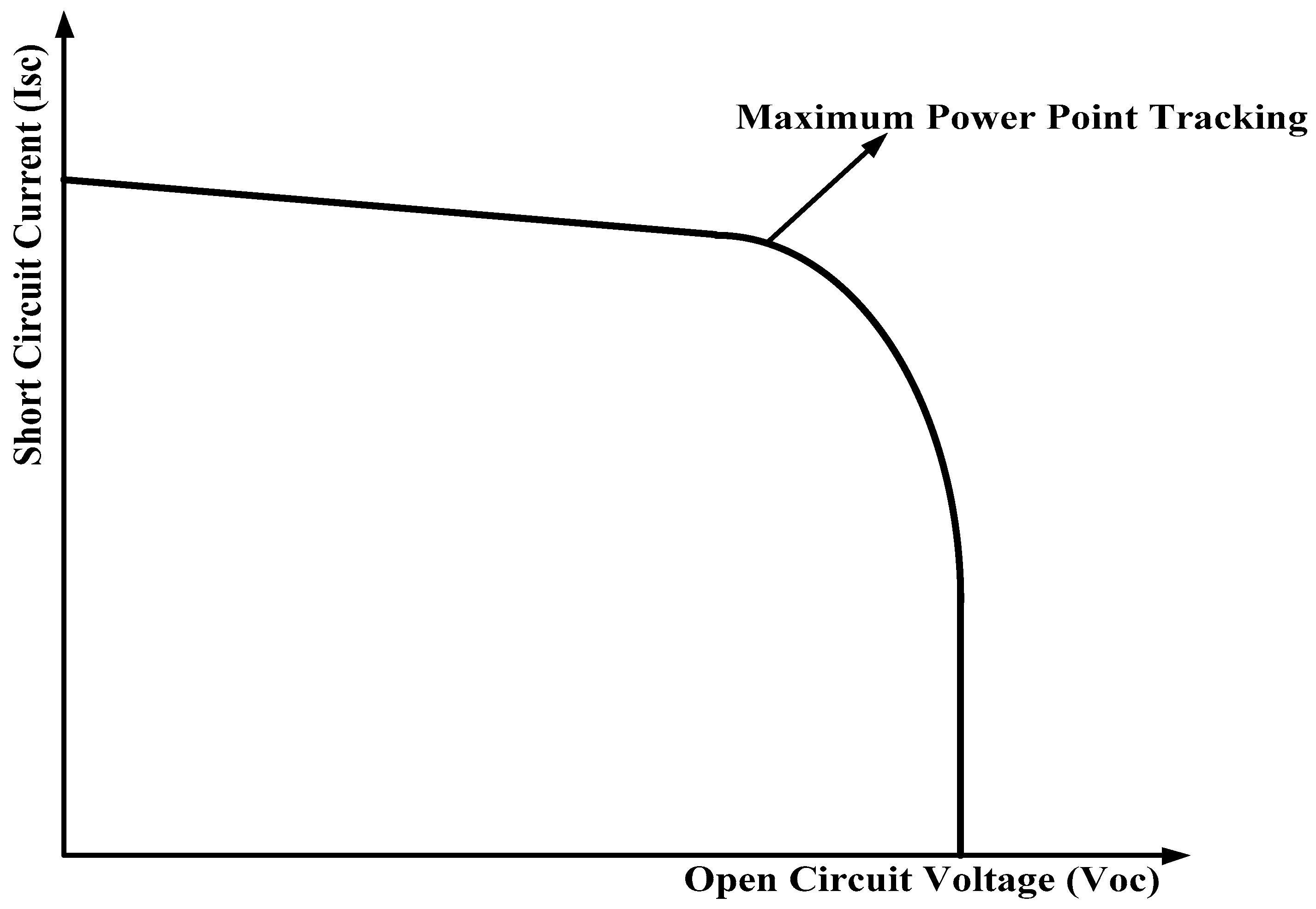

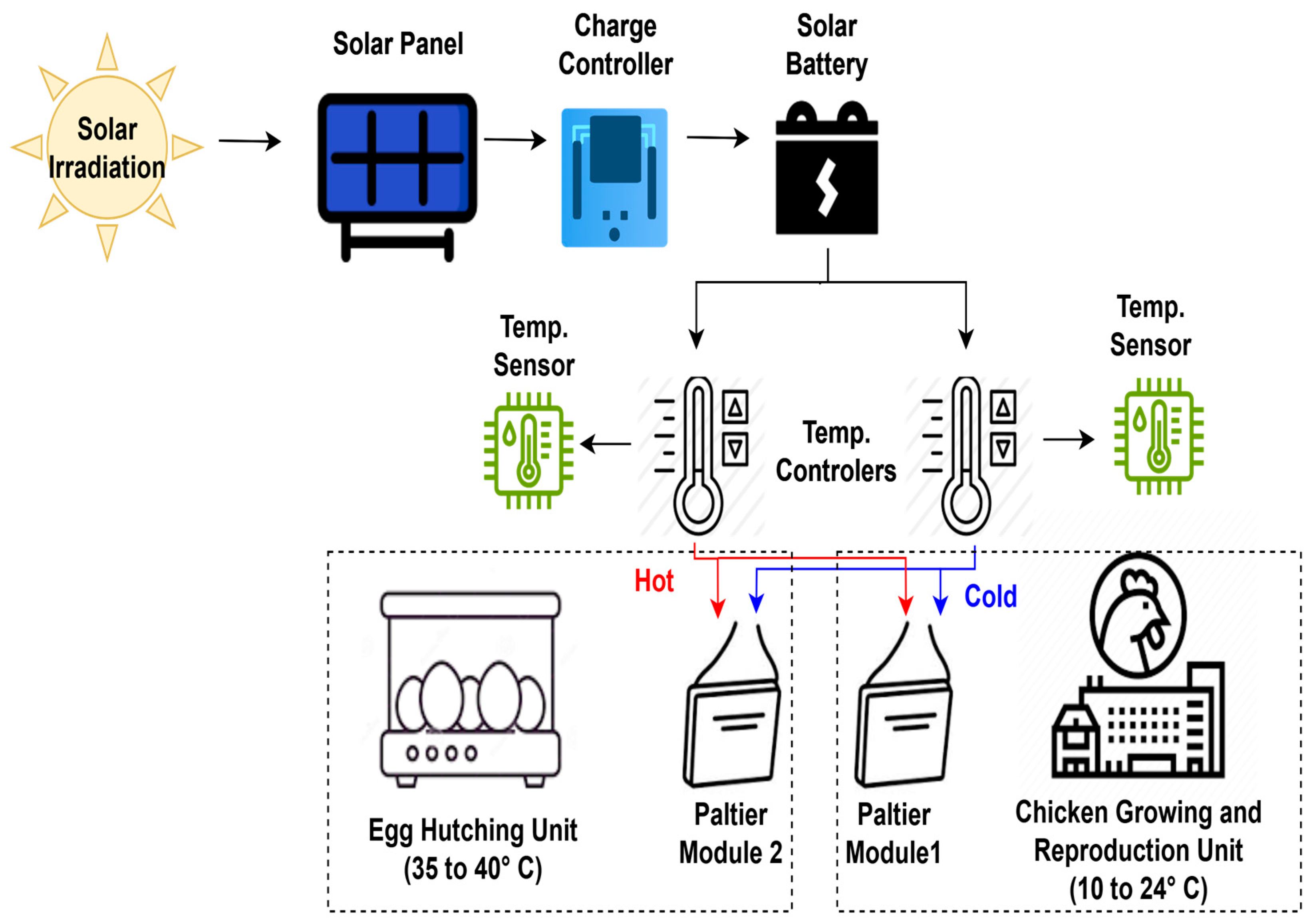

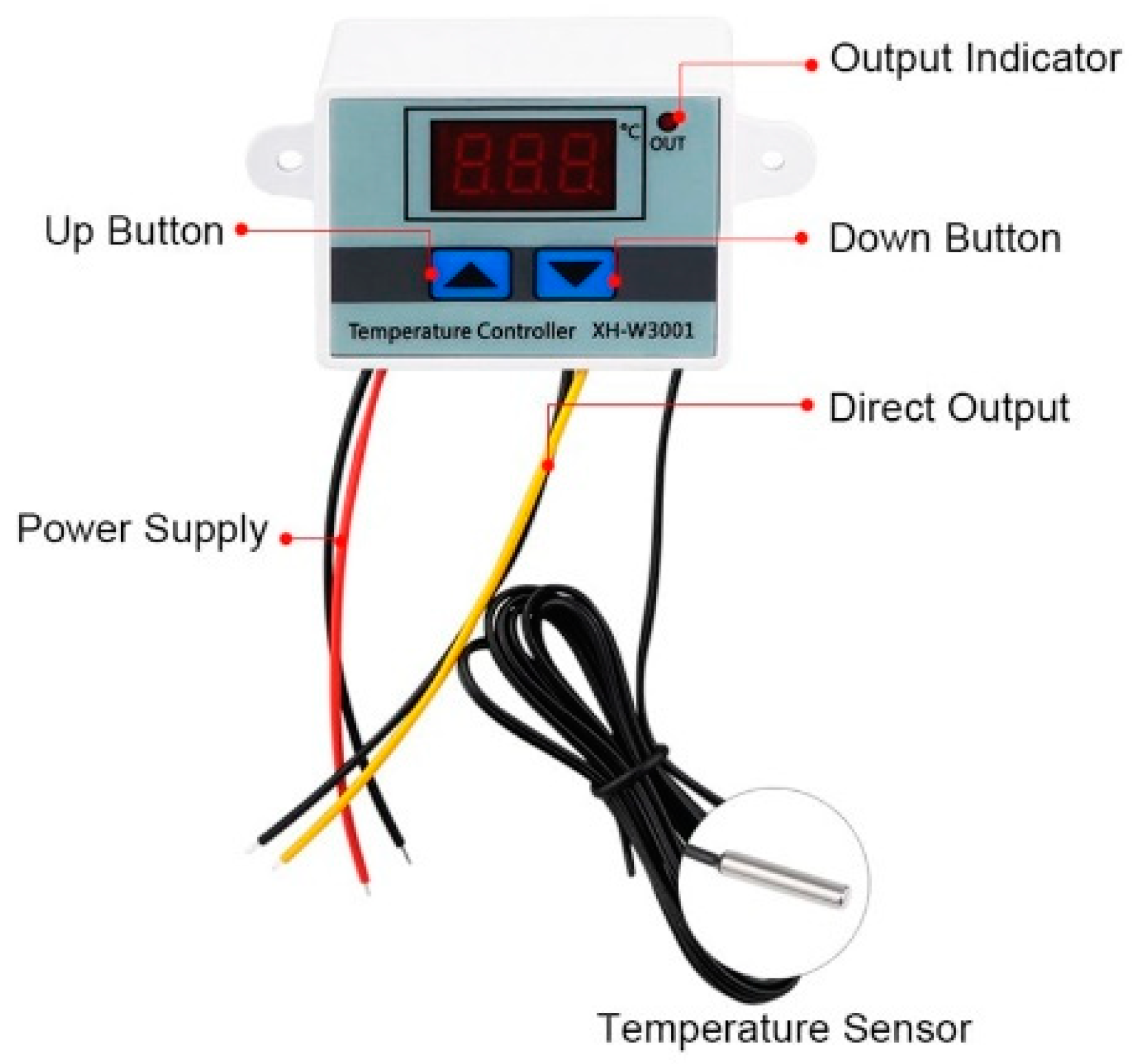
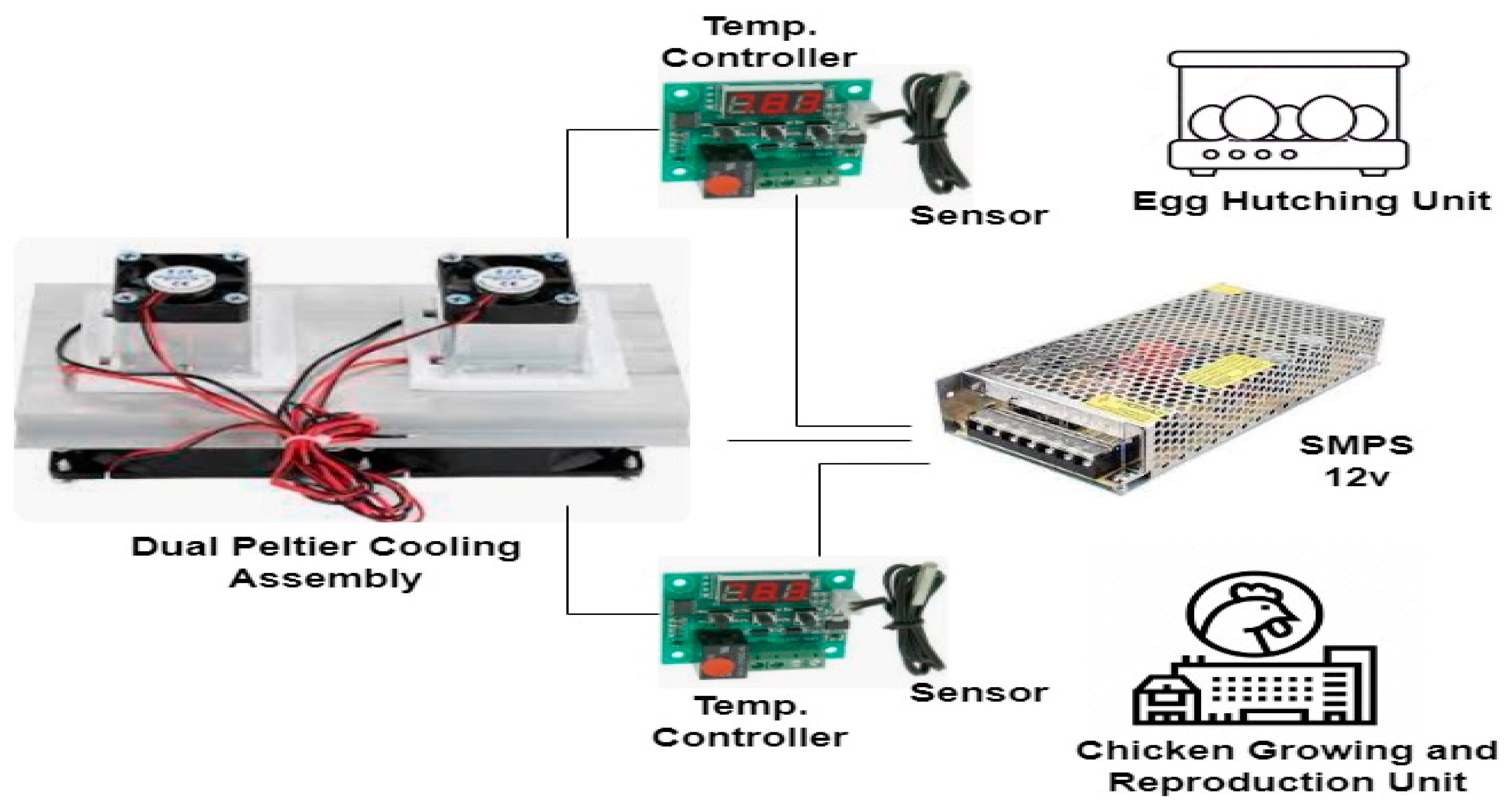
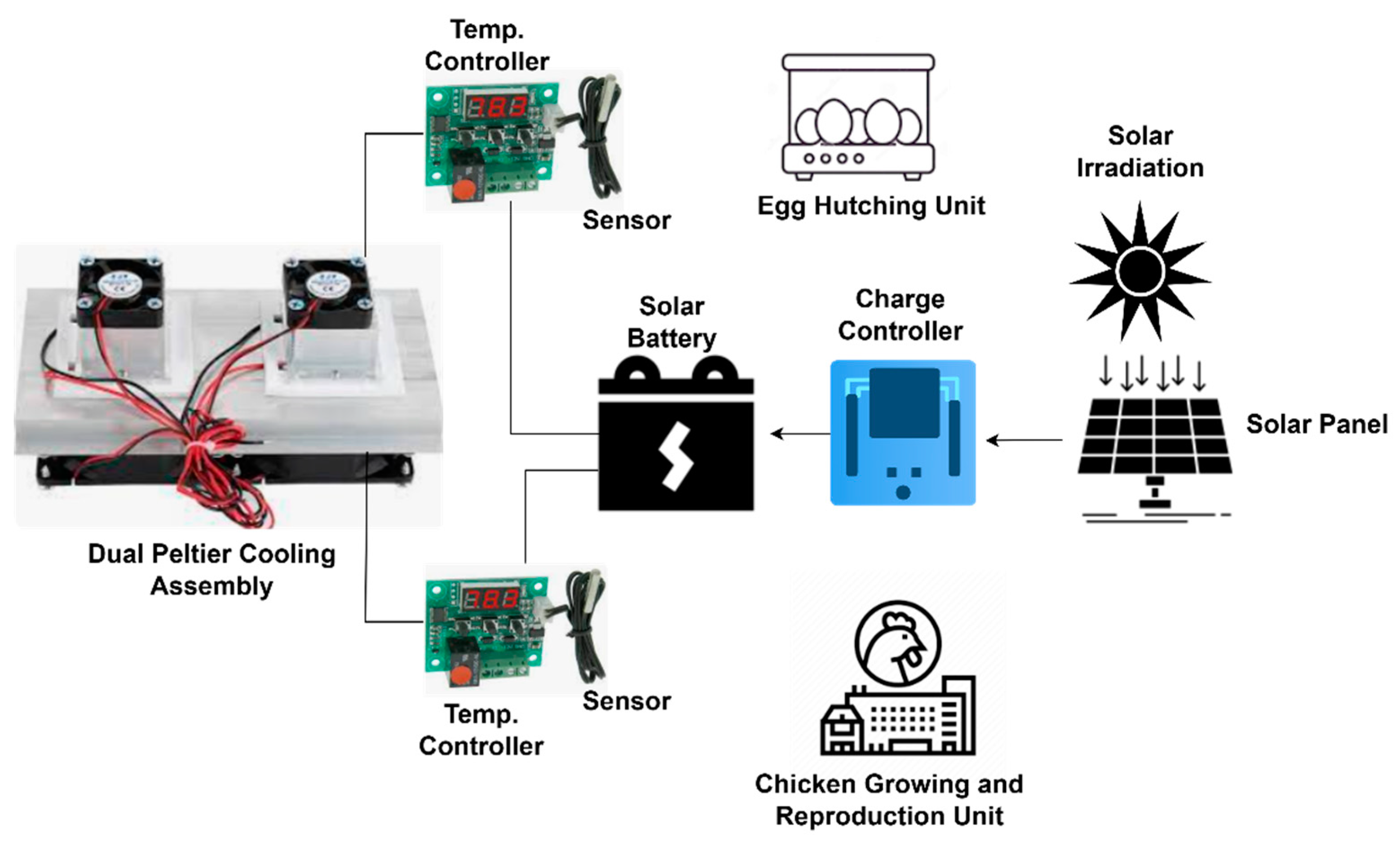
| Current (at 12 V) | Time to Reach 10 °C | Temperature after 1 h | Temperature after 2 h | |
|---|---|---|---|---|
| TEC1-12705 | 2.57 A | 56 min | 5.6 °C | 2.9 °C |
| TEC1-12704 | 2.73 A | 58 min | 6.2 °C | 6.7 °C |
| TEC1-12706 | 3.18 A | 59 min | 7.3 °C | 6.9 °C |
| TEC1-12703 | 3.47 A | 55 min | 5 °C | 2.6 °C |
| Current (at 12 V) | Time to Reach 50 °C | Temperature after 1 h | Temperature after 2 h | |
|---|---|---|---|---|
| TEC-12705 | 2.57 A | 54 s | 54.6 °C | 56.3 °C |
| TEC-12704 | 2.73 A | 55 s | 53.9 °C | 55.5 °C |
| TEC-12706 | 3.18 A | 56 s | 52.6 °C | 54.7 °C |
| TEC-12703 | 3.47 A | 45 min | 55.3 °C | 59.2 °C |
| Chicken-Growing and Reproduction Unit | Current in Amperes | Time in Minutes | Temperature in °C |
| 2.51 | 5 | 30 | |
| 2.64 | 10 | 28 | |
| 2.83 | 15 | 25 | |
| 2.92 | 20 | 22 | |
| 3.05 | 25 | 21 | |
| 3.12 | 30 | 20 | |
| 3.14 | 35 | 19 | |
| 3.15 | 40 | 17 | |
| 3.19 | 45 | 15 | |
| 3.21 | 50 | 12 | |
| 3.23 | 55 | 10 |
| Egg-Hatching Unit | Current in Amperes | Time in Minutes | Temperature in °C |
| 2.51 | 5 | 38 | |
| 2.64 | 10 | 41 | |
| 2.83 | 15 | 42 | |
| 2.92 | 20 | 44 | |
| 3.05 | 25 | 45 | |
| 3.12 | 30 | 46 | |
| 3.14 | 35 | 47 | |
| 3.15 | 40 | 48 | |
| 3.19 | 45 | 50 | |
| 3.21 | 50 | 51 | |
| 3.23 | 55 | 52 |
| Cost | Efficiency | Reliability | Production | Renewable | Energy Bills | COx Emissions | Payback | |
|---|---|---|---|---|---|---|---|---|
| Natural incubation | Moderate | Less | Less | Less | No | Moderate | Low | Not Applicable |
| Tube light incubation | High | Less | Less | Medium | No | Moderate | Low | Not Applicable |
| Forced air incubation | High | Moderate | Moderate | Medium | No | High | Moderate | Not Applicable |
| Still air incubation | High | Moderate | Moderate | Medium | No | High | Moderate | Not Applicable |
| Thermostat air incubation | High | Moderate | Less | Medium | No | High | Moderate | Not Applicable |
| Proposed method | Low | High | High | High | Yes | Zero | Zero | Applicable |
| Cost | Efficiency | Reliability | Production | Renewable | Energy Bills | COx Emissions | Payback | |
|---|---|---|---|---|---|---|---|---|
| Mechanical ventilation | Moderate | Less | Less | Less | No | Moderate | Low | Not Applicable |
| Evaporative cooling | Moderate | Less | Less | Medium | No | Moderate | Low | Not Applicable |
| Refrigerant cooling | High | High | Moderate | Medium | No | High | High | Not Applicable |
| Natural ventilation | Low | Moderate | Less | Medium | Yes | High | Zero | Not Applicable |
| Insulation and thermal regulation | High | Moderate | Less | Medium | No | High | Moderate | Not Applicable |
| Proposed method | Low | Moderate | High | Medium | Yes | Zero | Zero | Applicable |
| Hardware Component | Type | Rating |
|---|---|---|
| Solar panel | Monocrystalline | 12 Volt, 300 watts |
| Solar charge controller | MPPT | 24/12 Volt, 50 Amps |
| Tubular battery | Lead–Acid | 12 Volt, 100 Ah |
| Peltier modules and heat sinks | TEC1-12603 | 12 Volt, 3 Amps |
| Cooling fans | BLDC motor | 12 Volt, 1.8 watts |
| Heating fans | BLDC motor | 12 Volt, 3 watts |
| Temperature controllers with sensors | Thermocouple | 12 Volt, 10 Amps |
| Switched mode power supply | - | 12 Volt, 10 Amps |
Disclaimer/Publisher’s Note: The statements, opinions and data contained in all publications are solely those of the individual author(s) and contributor(s) and not of MDPI and/or the editor(s). MDPI and/or the editor(s) disclaim responsibility for any injury to people or property resulting from any ideas, methods, instructions or products referred to in the content. |
© 2024 by the authors. Licensee MDPI, Basel, Switzerland. This article is an open access article distributed under the terms and conditions of the Creative Commons Attribution (CC BY) license (https://creativecommons.org/licenses/by/4.0/).
Share and Cite
Cheepati, K.R.; Balal, N. Solar Powered Thermoelectric Air Conditioning for Temperature Control in Poultry Incubators. Sustainability 2024, 16, 4832. https://doi.org/10.3390/su16114832
Cheepati KR, Balal N. Solar Powered Thermoelectric Air Conditioning for Temperature Control in Poultry Incubators. Sustainability. 2024; 16(11):4832. https://doi.org/10.3390/su16114832
Chicago/Turabian StyleCheepati, Kumar Reddy, and Nezah Balal. 2024. "Solar Powered Thermoelectric Air Conditioning for Temperature Control in Poultry Incubators" Sustainability 16, no. 11: 4832. https://doi.org/10.3390/su16114832
APA StyleCheepati, K. R., & Balal, N. (2024). Solar Powered Thermoelectric Air Conditioning for Temperature Control in Poultry Incubators. Sustainability, 16(11), 4832. https://doi.org/10.3390/su16114832










